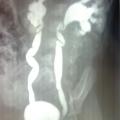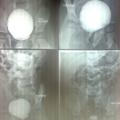You are here
Vesicoureteral Reflux
What is Vesicoureteric Reflux (VUR)?
VUR is a common pediatric urologic diagnosis. It means urine going in reverse direction from the urinary bladder into the kidneys (in normal course, urine flows only from the kidneys into the bladder & not vice-versa). many children with VUR may not have any symptoms & may outgrow their problem as they grow (especially lower grades 1 &2 of VUR). On the other hand, children with intermediate (grade 3) or high grade (grade 4 & 5) VUR may develop repeated kidney infections which can damage their kidneys. VUR is present in about 40% of children who develop kidney infection. Such a VUR that causes kidney infections will require treatment.
How is VUR Diagnosed?
VUR is diagnosed by a test called MCUG (or VCUG). In this test, a small tube is placed into the child's bladder, the bladder is filled with a dye & as the child is passing urine, a few x-rays are taken under a special x-ray machine called fluoroscopy.
What is the Treatment for VUR?
The treatment may be expectant (medical) or surgical correction of VUR. The decision as to which child receives what treatment is individualized & is best decided by an expert pediatric surgeon/pediatric urologist who has a large experience with managing such patients. Medical treatment consists of giving low-dose antibiotics daily to prevent urinary infections while waiting for the reflux to resolve by itself. Surgical correction of VUR is offered for children older than 1 year with high-grade VUR, failure of medical management, breakthru infections while on antibiotics, and/or children who have significant kidney damage at presentation itself.
What are the options for surgical correction of VUR?
There are many options.
1. Endoscopic correction of VUR (cystoscopic injection of Deflux).


MCUG of 18 month old boy showing bilateral grade 4 VUR. Repeat MCUG of the same child on the right showing complete resolution of VUR after Deflux injection
2. Open/Laparoscopic ureteric reimplantation. This is a major surgical procedure, whether open or laparosopic. There are many techniques. The ureter is usually disconnected from the bladder & is repositioned into the bladder thru a tunnel created within the bladder wall (in some techniques, the ureter may not be disconnected from the bladder). The success of this operation in expert hands is about 95-98%. Complications like recurrence of VUR & ureteric obstruction can occur in a small percentage of children. Dr Sekharam has personally performed over 300 ureteric reimplantation operations over the past 10 years, with excellent success. He is one of the few surgeons in the country performing laparoscopic ureteric reimplantation surgery in children
The technique of surgical procedure for correction of VUR that is best suited for your child should be decided on an individualised basis, based on the age of the child, grade of VUR, whether VUR is on one or both sides, etc. The doctor will discuss with you the various options & then you can discuss with the doctor & decide on the best option for your child.
Comments
URINE REFLUX
HOW TO CURE URINE REFLUX
surgical correction of VUR
Hello Dr.sekharam,
First of all thanks to you for writing an article about VUR.
My kid is your Patient in Rainbow Hospital. He has grade 3 reflux..
It would be very great if you can write more information in first technique of Surgical correction (about deflux injection procedure)
Thank you in advance.
Regards,
Karthik.